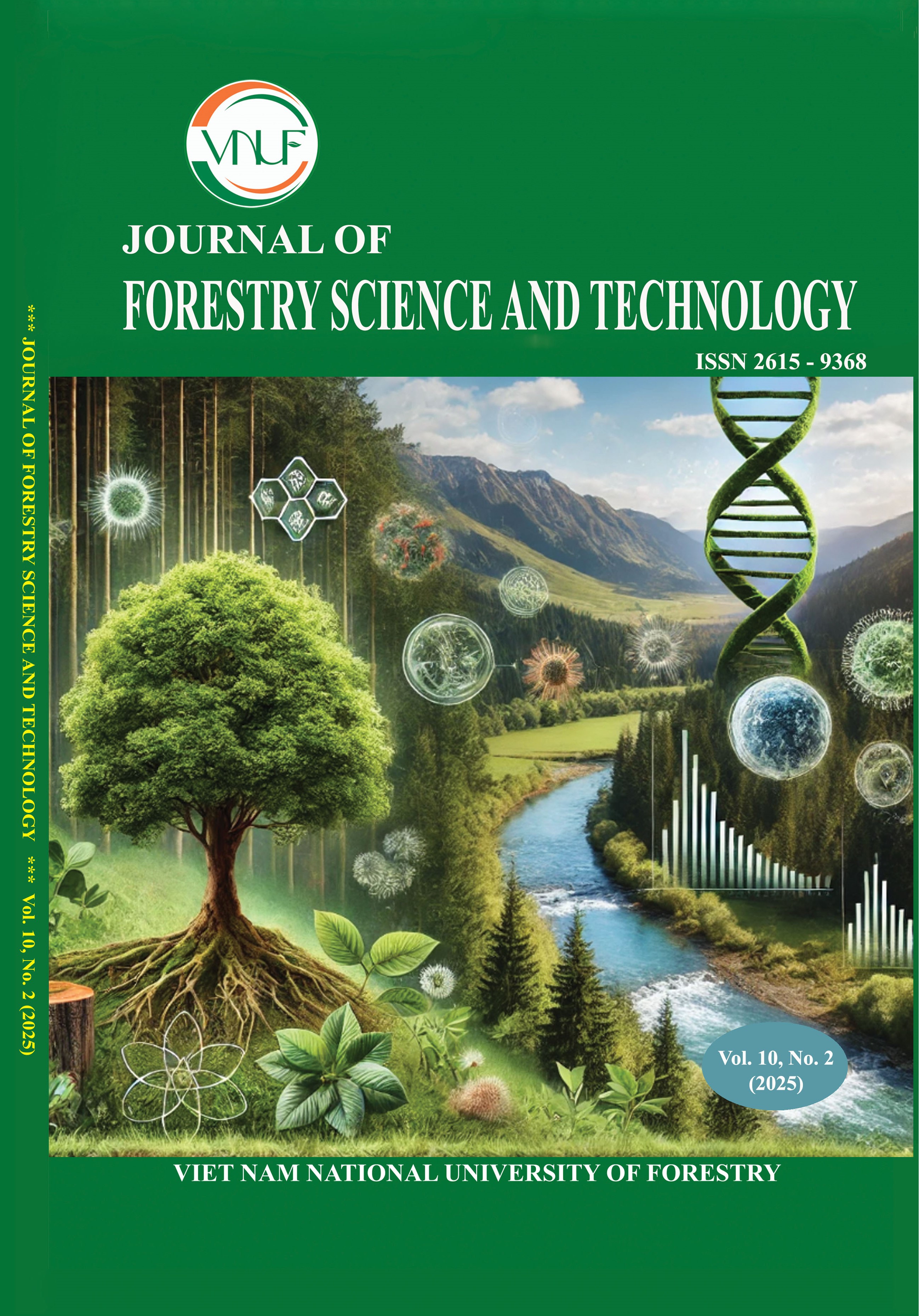Status, socio-ecological drivers and management implications of free-grazing livestock in Vietnam’s special-use forests
DOI:
https://doi.org/10.55250/Jo.vnuf.10.2.2025.072-080Keywords:
co-management, conservation management, Livestock grazing, socio-ecological drivers, special-use forest, VietnamAbstract
Livestock grazing in Vietnam’s special-use forest (SUF) system is both a social and ecological issue, reflecting the dependence of buffer-zone communities on forest resources while posing a challenge to biodiversity conservation. This study, conducted across 46 SUFs representing major ecological regions, combined quantitative and qualitative approaches to assess current grazing status, socio-ecological drivers, and management implications. Results revealed that 78.3% of SUFs had livestock grazing, with an average herd size of 45,486 ± 2,350 animals, of which 85.7% were free-ranging. Muong Nhe Nature Reserve was identified as a hotspot with 18,305 animals. The density of forest protection staff averaged 0.9 ± 0.4 persons per 1,000 ha—below the IUCN recommendation of about 2 persons per 1,000 ha—indicating limited human resources and management capacity. Regression analysis showed a strong correlation between herd size and the number of conservation violations (r = 0.985; R² = 0.97; p < 0.01), confirming herd size as a reliable indicator of ecological pressure. Qualitative analysis identified five key drivers: land scarcity, traditional practices, livelihood dependence, inadequate budgets, and weak coordination. The study proposes four management strategies: (i) strengthening institutional capacity and ecological monitoring technology; (ii) promoting co-management mechanisms; (iii) spatial planning for controlled grazing and alternative livelihoods; and (iv) integrating a One Health approach into conservation policies. The findings provide national-level empirical evidence on the socio-ecological mechanisms of livestock grazing, supporting adaptive management and sustainable development in buffer-zone communities.
References
[1]. Dong Thanh Hai & Ha Van Nghia (2025). Comprehensive report: Assessment of the current status and proposed solutions to mitigate livestock grazing and wildlife trapping activities in Vietnam’s Special-Use Forests. Hanoi: Department of Forestry – Forest Protection Department & IUCN Vietnam.
[2]. Li, J., Shi, X., He, X., Li, D., Hu, Q., Zhang, Y. & Ran, J. (2023). Free-ranging livestock affected the spatiotemporal behavior of the endangered snow leopard (Panthera uncia). Ecology and Evolution. 13(4): e9992.
[3]. Pudyatmoko, S. (2017). Cattle grazing and wildlife conservation in savanna ecosystems: Lessons from Baluran National Park, Indonesia. Biodiversity and Conservation. 26(9): 2369–2383.
[4]. Salvatori, M., Obersoler, V. & Augugliaro, C. (2022). Effects of free-ranging livestock on occurrence and interspecific interactions of a mammalian community. Ecological Applications. 32(7): e2644.
[5]. Hu, Y., Feng, J., Wang, H., Ge, J. & Wang, T. (2024). Wild ungulates and cattle have different effects on litter decomposition as revealed by fecal addition in a Northeast Asian temperate forest. Ecology and Evolution. 14(3): e70529.
[6]. Vu Anh Tai, Tran Thi Thuy Van, Bui Quang Tuan & Le Duc Hoang (2023). Ecological characteristic of grazing vegetation and capacity food for the large cattle in Central Highland, Vietnam. VNU Journal of Science: Earth and Environmental Sciences. 39(2): 122–132.
[7]. Government of Vietnam (2018). Decree No. 156/2018/NĐ-CP detailing the implementation of several articles of the Law on Forestry, as amended and supplemented by Decree No. 91/2021/ND-CP.
[8]. IUCN, UNDP, WHO, WOAH & EcoHealth Alliance (2025). Nature for Health (N4H): Annual Programme Narrative Report 2024. Geneva–New York: UNDP–MPTF Office.
[9]. Maina, L. W. & Nzengya, D. M. (2022). Analysis of socio-economic drivers of cattle grazing and grass harvesting in the Mount Kenya West Protected Forest. African Multidisciplinary Journal of Research. 7(1): 55–72.
[10]. Lama, S. T., Rai, R., Koirala, R. K. & Regmi, G. R. (2020). Assessment of the impacts of livestock grazing on endangered red panda habitat in eastern Nepal. Journal of Ecology. 10(3): 97–110.
[11]. Hull, V., Zhang, J., Zhou, S., Huang, J., Viña, A., Liu, W., … & Liu, J. (2014). Impact of livestock on giant pandas and their habitat. Journal for Nature Conservation. 22(3): 256–264.
DOI: 10.1016/j.jnc.2014.01.001.
[12]. Soofi, M., Ghoddousi, A., Zeppenfeld, T., Shokri, S. & Waltert, M. (2018). Livestock grazing in protected areas and its effects on large mammals in the Hyrcanian forest, Iran. Biological Conservation. 217: 377–385.
DOI: 10.1016/j.biocon.2017.11.009
[13]. Musaka, V. N., Nyundo, B. A. & Kideghesho, J. R. (2021). Spatio-temporal patterns of illegal livestock grazing in the Moyowosi–Kigosi Game Reserve, Tanzania. Land. 10(12): 1325.
DOI: 10.3390/land10121325.
[14]. Hu, J., Xu, C. & Zheng, Y. (2025). Effectiveness of conservation measures based on assessment of grazing intensity in the Yellow River source region, China. Land. 14(4): 813. DOI: 10.3390/land14040813.
[15]. Parr, J. W. K., Phommasane, S. & Kitamura, S. (2013). Multi-level co-management in government-designated protected areas: Opportunities to learn from models in mainland Southeast Asia. PARKS. 19(2): 59–74. DOI: 10.2305/IUCN.CH.2013.PARKS-19-2.JWP.en
[16]. Thapa, K., Subedi, N. & Pant, S. (2016). Grazing intensity and species diversity in mountain grassland ecosystems: A test of the intermediate disturbance hypothesis. Mountain Research and Development. 36(3): 308–317.
DOI: 10.1659/MRD-JOURNAL-D-16-00017.1









